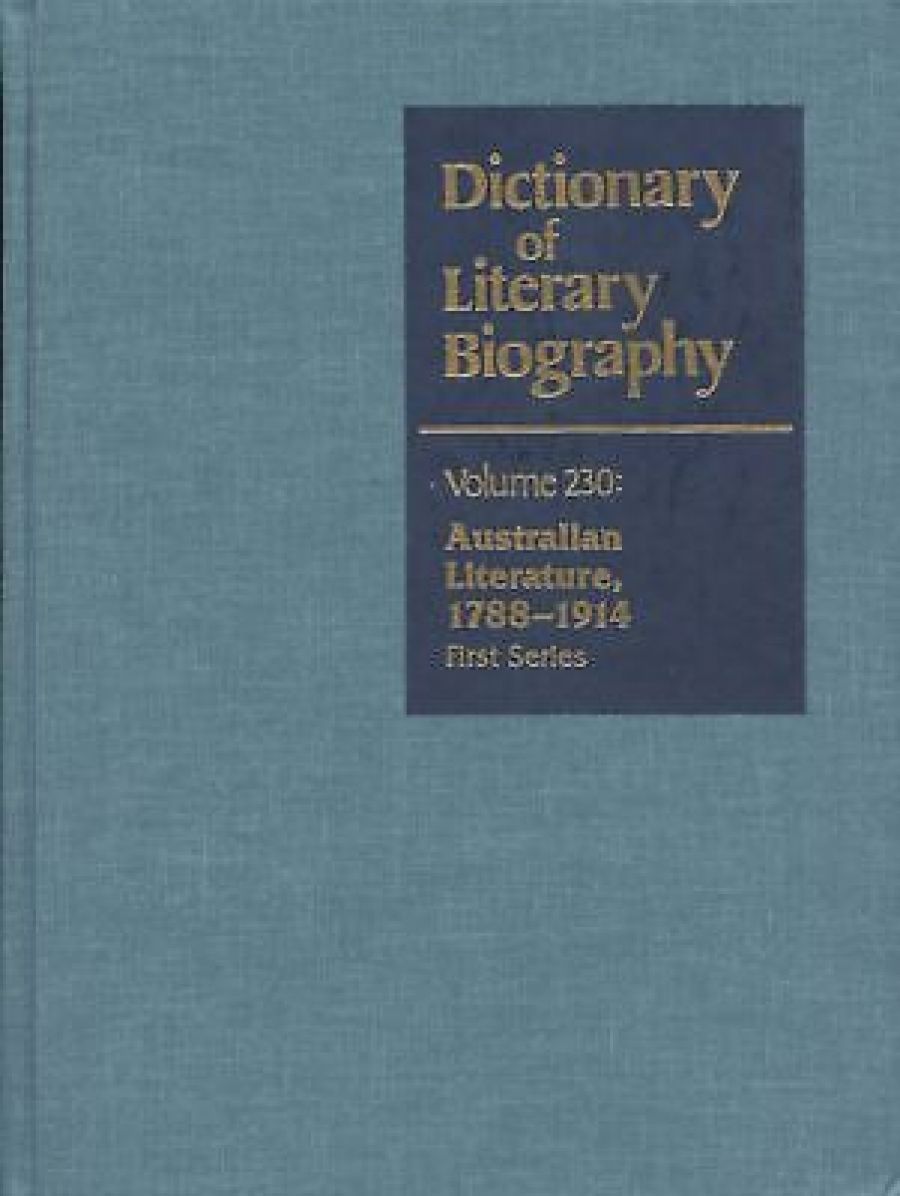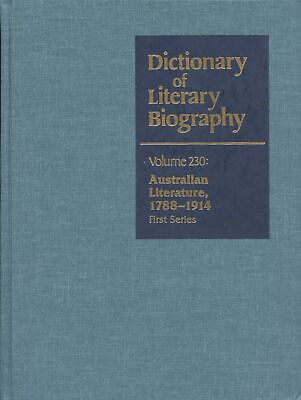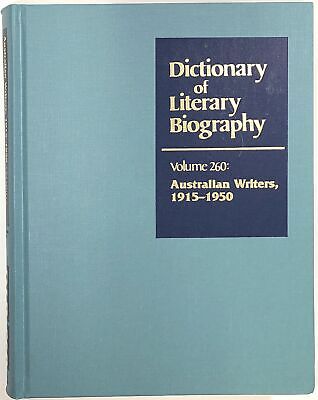
- Free Article: No
- Contents Category: Literary Studies
- Review Article: Yes
- Article Title: Fashion Mistakes
- Online Only: No
- Custom Highlight Text:
The Biographa literaria, to coin a phrase, began publication in 1978 and has now reached volume 272, Russian Prose Writers between the World Wars. It is a major work of reference that not only includes creative writers but also critics, publishers, journalists, historians and book collectors: ‘figures who in their time and in their way influenced the mind of a people.’ Most of the volumes deal with American and British literature, but others cover the literatures of Canada, a number of European countries, Latin America, Russia, Africa, Japan, and the literatures of classical Greece and Rome. Now Australia has been honoured with a place in this monumental work and the chance to have its literature on show around the world. The two Australian volumes published to date cover writers whose first important work was published up to the end of 1950. Two more volumes are planned to bring the story up to 2000.
- Book 1 Title: Dictionary of Literary Biography Volume 230
- Book 1 Subtitle: Australian literature 1788–1914
- Book 1 Biblio: Gale Group, US $150 hb, 519 pp
- Book 1 Cover Small (400 x 600):

- Book 1 Cover (800 x 1200):

- Book 2 Title: Dictionary of Literary Biography Volume 260
- Book 2 Subtitle: Australian Writers 1915-1950
- Book 2 Biblio: Gale Group, US $150 hb, 519 pp
- Book 2 Cover Small (400 x 600):

- Book 2 Cover (800 x 1200):

The date of an author’s first important work determines in which volume the entry will appear. It would probably have been better to have taken the Australian Dictionary of Biography’s criterion, which is the period in which a person was most active. As it is, Miles Franklin, Henry Handel Richardson and Mary Grant Bruce, for example, appear in the first volume among the colonials, by virtue of early successes, whereas their colleagues are all in the second volume.
The entries are written by Australians, mainly academics. Each is extensive, without being unwieldy, and very readable, without the use of jargon. There is an excellent combination of biographical information, textual analysis and literary criticism. Each entry has a full list of the subject’s publications, including selected periodical publications, preceding the entry. At the conclusion are a bibliography and a note on the location of the subject’s papers. Each entry is very clearly set out and well illustrated, often including illustrations of the author’s manuscripts or typescripts.
I valued the opportunity to read the relatively recent research into a number of forgotten nineteenth-century women writers; for example, Mary Fortune, Mary Gaunt, Caroline Leakey and Catherine Martin. They were all indomitable, successful, gutsy women who often endured much personal tragedy. The meticulous research of the authors of these entries is conveyed engagingly. Michael Ackland’s entry on Patrick White is outstanding. He deftly intertwines life and work, succinctly capturing the man. One could impress a dinner party just by rehearsing Ackland’s article (without acknowledgment, of course). Well, a dinner party in Sydney at least: Melbourne would not be so easily taken in by such front. Alan Lawson on Barbara Baynton is another stunner: what a life, what a book (Bush Studies, 1902).
Biography can be a rewarding approach to literary history. A reading of these volumes is not only immensely educative; it is also immensely enjoyable. You cannot say that about all reference books. It is difficult to curl up with these books as they are large and sturdily bound, as befits works of reference, but if the entries were put between bright covers with some of the illustrations in colour, you would have a marvellously accessible history of Australian literature.
That completes the case for the defence. The case for the prosecution does not have a happy ending. All books contain errors of fact, but there is a responsibility on compilers of works of reference to be meticulous. Facts are, after all, one of the reasons we consult these works. These two volumes are littered with errors.
Dates of birth are basic. There is no excuse for printing Ethel Turner’s birth date as 1872 when A.T. Yarwood’s 1994 biography established that it was 1870. Barron Field’s is 1786, not 1789. I cannot understand why the author of Ruth Park’s entry would note that her birth date has been variously cited in the past, and then opt for 1923 with a question mark, when in Park’s Who’s Who entry, the data for which came from Park, the date is given unequivocally as 1923.
Personal names are misspelt; sources for illustrations are incorrect; names of institutions and organisations are mangled; publication dates for books are wrong. Manning Clark would hardly have described Nettie Palmer as ‘the great life-affirmer, the giver of the waters of life’ (which she was) in Volume One of his History, as that only went up to 1822, sixty-three years before Palmer was born. That is, if we can believe Palmer’s birth date as given here. Readers will be surprised to be told that Marjorie Barnard expressed a conventional 1960s view of Miles Franklin’s My Brilliant Career when they are also told that the book in which she did this was published in 1988. We all know that P.R. Stephensen was not the literary editor of the Bulletin; but will they know this in Los Angeles or Moscow or Bombay? They may smell a rat, though, as later in the same paragraph the name is spelt Stephenson. And on it goes; an editor’s delight (or nightmare), really.
These volumes are also impaired as works of reference because of the omission of so many relevant literary figures. Louise Mack, Dorothea Mackellar, Zora Cross, Jeannie Gunn and Louis Stone are a few who ought to have been in Volume 230. In Volume 260, you will search in vain for Eve Langley, Kylie Tennant, May Gibbs (those wicked Banksia Men will have their revenge), Ian Mudie, Pamela Travers (Mary Poppins is not amused!), Dorothy Wall (poor Blinky Bill), Ethel Anderson and Betty Roland. Surely, you cannot pretend to compile a reference work on Australian literature without including J.F. Archibald, George Robertson, A.W. Jose, or H.M. Green, to name just four. Book collectors are specifically mentioned as a category to be included in this project. May I be so bold, then, as to enquire what happened to David Scott Mitchell, without whom much of the research presented in these volumes would not have been possible?
The decision to divide the volumes at 1914 was made, so the editor tells us, because of the crucial nature of World War I on Australian culture. The significance on the national consciousness of the type of Australian portrayed in C.E.W. Bean’s official war history is noted. So why is there no entry on Bean?
The editor knows all is not well. ‘There have inevitably been omissions in this volume [Volume 260], attributable to the usual problems of editorial selection and the more unexpected hindrances of scholarly fashion.’ I do not know what this means exactly, but we cannot simply exclude someone from a major biographical dictionary on the basis that he or she is not the scholarly fashion of the moment. ‘While the omissions are much regretted, they do indicate that the study of a national literature is not a matter of closure, but a continuous process of discovery and revelation.’ But the omissions do not need to be discovered or revealed; they are already known.
As a major work of reference, these volumes make an excellent series of essays.


Comments powered by CComment